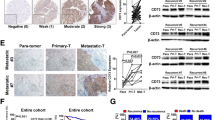Abstract
Hepatocellular carcinomas (HCC) are aggressive cancers, and the prognosis of HCC patients is poor. This study investigated the roles of CD29 in epithelial–mesenchymal transition (EMT) and chemoresistance and radioresistance in HCC tumors. CD29 expression in HCC and peritumoral tissues was measured by immunohistochemistry. CD29 overexpression was established by an adenovirus-carrying CD29 gene expression cassette, while silencing of CD29 expression was established by an adenovirus-carrying shRNA. Western blot was used to measure protein expression, and MTT was used to analyze cell viability. Xenograft HCC mouse model was established by inoculating isolated CD29+ and CD29− HCC tumor cells. Significantly higher percentage of positive CD29 expression was observed in HCC tissues compared to peritumoral tissues. Xenograft CD29+ tumors grew more quickly than CD29− tumors. CD29+ tumors were more resistant to radiotherapy and cisplatin therapy than CD29− tumors. Overexpression of CD29 significantly increased the resistance of CD29− tumors to radiation and cisplatin treatment. In contrast, silencing of CD29 expression significantly sensitized CD29+ tumors to irradiation and cisplatin treatment. Overexpression of CD29 decreased E-cadherin, but increased fibronectin, vimentin, ILK activity, Akt Ser473 phosphorylation, and mTORC1 protein expression in Hep G2 and THLE-3 cells. Moreover, overexpression of CD29 significantly increased the resistance of Hep G2 and THLE-3 cells to starvation, radiation, and cisplatin treatments. This study suggests that CD29 plays a crucial role in the resistance of HCC to chemo/radiotherapy and EMT of liver epithelial cells.




Similar content being viewed by others

References
Chen WQ, Zheng RS, Zhang SW. Liver cancer incidence and mortality in China, 2009. Chin J Cancer. 2013;32:162–9.
Siegel R, Ma J, Zou Z, et al. Cancer statistics, 2014. CA Cancer J Clin. 2014;64:9–29.
Chen X, Liu HP, Li M, et al. Advances in non-surgical management of primary liver cancer. World J Gastroenterol. 2014;20:16630–8.
Yang N, Ekanem NR, Sakyi CA, Ray SD. Hepatocellular carcinoma and microRNA: new perspectives on therapeutics and diagnostics. Adv Drug Deliv Rev. 2014;81:62–74.
Roussel E, Gingras MC, Ro JY, Branch C, Roth JA. Loss of α1β1 and reduced expression of other beta 1 integrins and CAM in lung adenocarcinoma compared with pneumocytes. J Surg Oncol. 1994;56:198–208.
Oloumi A, McPhee T, Dedhar S. Regulation of E-cadherin expression and beta-catenin/Tcf transcriptional activity by the integrin-linked kinase. Biochim Biophys Acta. 2004;1691:1–15.
Riaz A, Zeller KS, Johansson S. Receptor-specific mechanisms regulate phosphorylation of AKT at Ser473: role of RICTOR in β1 integrin-mediated cell survival. PLoS One. 2012;7:e32081.
Lahlou H, Muller WJ. β1-integrins signaling and mammary tumor progression in transgenic mouse models: implications for human breast cancer. Breast Cancer Res. 2011;13:229.
Liu LX, Jiang HC, Liu ZH, Zhou J, Zhang WH, Zhu AL, Wang XQ, Wu M. Integrin gene expression profiles of human hepatocellular carcinoma. World J Gastroenterol. 2002;8:631–7.
Zhao G, Cui J, Qin Q, Li SS, Yin T, Chen LB, Wu HS, Wang CY. The expression of integrin beta 1 in normal hepatic tissues, hepatic cirrhosis tissues and hepatocellular carcinoma]. Chin J Hepatol. 2010;18:353–6.
Tian J, Tang ZY, Ye SL, Liu YK, Lin ZY, Chen J, Xue Q. New human hepatocellular carcinoma (HCC) cell line with highly metastatic potential (MHCC97) and its expressions of the factors associated with metastasis. Br J Cancer. 1999;81:814–21.
Tong CM, Ma S, Guan XY. Biology of hepatic cancer stem cells. J Gastroenterol Hepatol. 2011;26:1229–37.
Geng S, Guo Y, Wang Q, Li L, Wang J. Cancer stem-like cells enriched with CD29 and CD44 markers exhibit molecular characteristics with epithelial–mesenchymal transition in squamous cell carcinoma. Arch Dermatol Res. 2013;305:35–47.
Scanlon CS, Van Tubergen EA, Inglehart RC, D’Silva NJ. Biomarkers of epithelial–mesenchymal transition in squamous cell carcinoma. J Dent Res. 2013;92:114–21.
Morra L, Moch H. Periostin expression and epithelial–mesenchymal transition in cancer: a review and an update. Virchows Arch. 2011;459:465–75.
Satpute PS, Hazarey V, Ahmed R, Yadav L. Cancer stem cells in head and neck squamous cell carcinoma: a review. Asian Pac J Cancer Prev. 2013;14(10):5579–87.
Liu DC, Yang ZL. Overexpression of EZH2 and loss of expression of PTEN is associated with invasion, metastasis, and poor progression of gallbladder adenocarcinoma. Pathol Res Pract. 2011;207:472–8.
Zhang X, Hu K, Li CY. Protection against oxidized low-density lipoprotein-induced vascular endothelial cell death by integrin-linked kinase. Circulation. 2001;104:2762–6.
Zhang Y, Zhu X, Bai M, Zhang L, Xue L, Yi J. Maternal deprivation enhances behavioral vulnerability to stress associated with miR-504 expression in nucleus accumbens of rats. PLoS One. 2013;8:e69934.
Li M, Dai FR, Du XP, Yang QD, Zhang X, Chen Y. Infusion of BDNF into the nucleus accumbens of aged rats improves cognition and structural synaptic plasticity through PI3 K-ILK-Akt signaling. Behav Brain Res. 2012;231:146–53.
Acknowledgments
This study was supported by The Foundation of Major International Cooperation Projects of The Science and Technology (2010DFB30300) and the National Natural Science Foundation of China (81272193), National Basic Research Program of China (2010CB833605).
Conflict of interest
All authors declared no conflict of interest.
Author information
Authors and Affiliations
Corresponding authors
Rights and permissions
About this article
Cite this article
Jiang, X., Wang, J., Zhang, K. et al. The role of CD29-ILK-Akt signaling-mediated epithelial–mesenchymal transition of liver epithelial cells and chemoresistance and radioresistance in hepatocellular carcinoma cells. Med Oncol 32, 141 (2015). https://doi.org/10.1007/s12032-015-0595-x
Received:
Accepted:
Published:
DOI: https://doi.org/10.1007/s12032-015-0595-x



